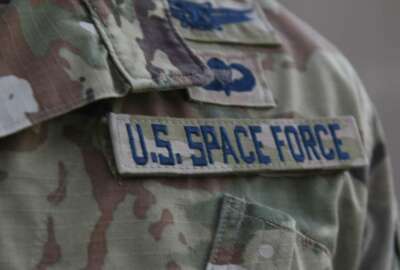New details are emerging on how the 18th member of the intelligence community will be set up as the Space Force continues to entrench itself as the newest service of the military.
Maj. Gen. Leah Lauderback, Air Force director of Intelligence Surveillance and Reconnaissance, said within a year the military will set up a National Space Intelligence Center (NSIC).
The center will develop from the two core space squadrons — space analysis and counter space analysis — that are now at the National Air and Space Intelligence Center (NASIC).
“Those squadrons will be the nucleus, they’d be the core of NSIC and then we will smatter a little bit of overhead on that to ensure that they’re getting what they need,” Lauderback said. “We absolutely want that to be co-located with NASIC. As a commander, there’s no way that we want to destroy the synergy that comes out of all of these squadrons being able to walk down the hallway and talk to each other.”
Lauderback said the Air Force and Space Force are looking into the engineering and modeling and other final assessments they need to station the two centers together.
As far as priorities go, the Space Force’s intelligence sector will be joining an already crowded community. There were questions when the Space Force was set up about how its intelligence capabilities would coincide, and not overlap, with the National Reconnaissance Office.
“One of the priorities is the matter of trying to develop capability that gives us a confirmation and competence and calls that we’re making on the attributes of who’s making an activity on orbit,” Lauderback said. “It’s just is so much more difficult in trying to characterize something that happens 12,000 miles away, or however many more miles away and something that flies over the earth once every 90 minutes all through technical means.”
Lauderback said the Space Force needs more sensors and presence in orbit to get that information.
“I just want to be able to make a more confident call and in a faster manner, so that I’d say one of my high priorities is being able to characterize the threats out there,” she said.
Another priority is bettering agreements and education with Five Eye partners and other allies.
The Space Force announced last month that it would be the newest member of the intelligence community. It still needs to submit its plans to Congress on how it will go about making the move.
The service just graduated its first seven enlisted trainees from basic training.
The Space Force identified 6,400 people from the Air Force who will move to the new service — 2,400 have already made the switch. Additionally, 86 Air Force Academy cadets have been commissioned into the Force.
“We are in the process as we speak of interviewing Air Force Academy cadets for next year’s class,” Chief of Space Operations Gen. Jay Raymond said. “This next year, we’ll have 98 cadets that will come over, and we’re interviewing every single person that comes into the Space Force to be very, very selective.”
For officers and enlisted, the Space Force is comprised of six career fields: Space operations, cyber operators, acquisition, engineering, cyber and intelligence.
“Because we brought those units underneath the Space Force leadership, now we have to develop those folks to fill those positions and do that organically,” Raymond said. “As new missions come about, we will add squadrons. But from the beginning, we baseline this with the units that were already in the Air Force bringing them over, and then being able to develop the manpower that fills those units today.”
Copyright
© 2024 Federal News Network. All rights reserved. This website is not intended for users located within the European Economic Area.


